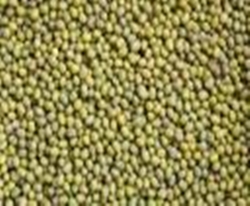Green Gram
-
The mung or moong bean (also known as green gram or golden gram) is the seed of Vigna radiate native to the Indian subcontinetand mainly cultivated in India, Pakistan, China, Thailand, Philippines, Indonesia,Burma, Bangladesh, Vietnam, Laos and Cambodia, but also in hot and dry regions of Southern Europe and the Southern United States.
-
We provide a wide range of Indian Pulses Sourced from the reliable vendors, our Indian Pulses are the perfect blend of nutritious level and quality. Highly delectable, our Indian Pulses are significant source of proteins. We are strongly associated with Mayanmar, Turkey, Iran, China and Canada for best shipping.
-
It is used as an ingredient in both savory and sweet dishes. Green gram, also known as the mung bean, is a small round bean similar in shape to the field pea. People in the U.S. primarily eat green gram as a sprout, and as a bean it cooks up fast and has a sweet flavor. With its high fiber and nutrient content, it offers a number of health benefits. Mung beans are commonly used in various cuisines across Asia. Whole cooked mung beans are generally prepared from dried beans by boiling until they are soft. Mung beans are light yellow in colour when their skins are removed.Mung bean paste can be made by dehulling, cooking, and pulverizing the beans to a dry paste.
-
Although whole mung beans are also occasionally used in Indian cuisine, beans without skins are more commonly used; but in Kerala, whole mung beans are commonly boiled to make a dry preparation often served with rice gruel (kanji). Dehulled mung beans can also be used in a similar fashion as whole beans for the purpose of making sweet soups. Mung beans in some regional cuisines of India are stripped of their outer coats to make mung dal. In Tamil Nadu and Andhra Pradesh, steamed whole beans are seasoned with spices and fresh grated coconut in a preparation called sundal.
-
They are soaked in water for six to 12 hours (the higher the temperature, the lesser soaking time). Then they are ground into fine paste along with ginger and salt. Then pancakes are made on a very hot griddle. These are usually eaten for breakfast. This provides high quality protein that is rare in most Indian regional cuisines. Pongal or kichdi is another recipe that is made with rice and mung beans without skin. In Kerala, it is commonly used to make the parippupreparation in the Travancore region (unlike Cochin and Malabar, where toor dal, tuvara parippu, is used). It is also used, with coconut milk and jaggery, to make a type of payasam.
-
Mung bean paste is also a common filling of pastries known as hopia (or bakpia) popular in Indonesia, the Philippines and further afield in Guyana (known as black eye cake) and originating from southern China.The mung bean was domesticated in Mongolia, where its progenitor (Vigna radiatasubspecies sublobata) occurs wild.Archaeological evidence has turned up carbonized mung beans on many sites in India.Areas with early finds include the eastern zone of the Harappan civilization in Punjab and Haryana, where finds date back about 4500 years.
-
South India in the modern state of Karnataka where finds date back more than 4000 years. Some scholars therefore infer two separate domestications in the northwest and south of India. In South India there is evidence for evolution of larger-seeded mung beans 3500 to 3000 years ago.By about 3500 years ago mung beans were widely cultivated throughout India. Cultivated mung beans later spread from India to China and Southeast Asia. Archaeobotanical research at the site of Khao Sam Kaeo in southern Thailand indicates that mung beans had arrived in Thailand by at least 2200 years ago. Finds on Pemba Island indicate that during the era of Swahili trade, in the 9th or 10th century, mung beans also came to be cultivated in Africa
-
The American Heart Association recommends you get 4,700 milligrams of potassium a day. Eating a potassium-rich diet helps lower blood pressure by counteracting the effects of sodium. One cup of cooked green gram contains 537 milligrams of potassium; that's more than 10 percent of the recommended daily amount. Most Americans get their protein from meat, poultry and eggs, according to the U.S. Department of Agriculture. The 2010 Dietary Guidelines for Americans recommends that you eat a variety of foods rich in protein, such as beans, so that you vary your nutrient intake. Green gram, with 14 grams of protein per 1-cup serving, fits the bill as an alternative nutrient-rich source of protein to your usual chicken or steak.
-
Iron deficiency affects 80 percent of the world's population, according to the World Health Organization. Women and children have the greatest need for iron and are at the most risk for deficiency. Not getting enough iron in the diet is one reason deficiency occurs. As a source of iron, green gram can help you meet your daily iron needs. A 1-cup serving contains 2.83 milligrams, which is more than 3 ounces of dark meat turkey. Combining your green gram with a vitamin C-rich food, such as peppers, helps with iron absorption..
